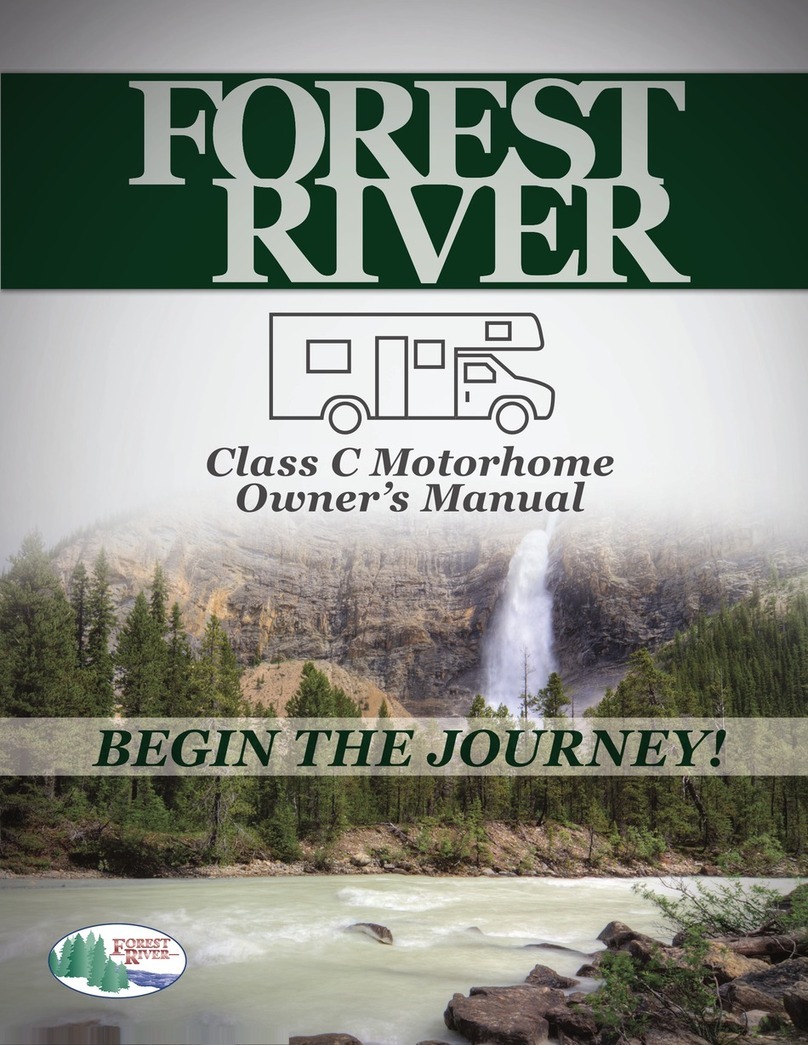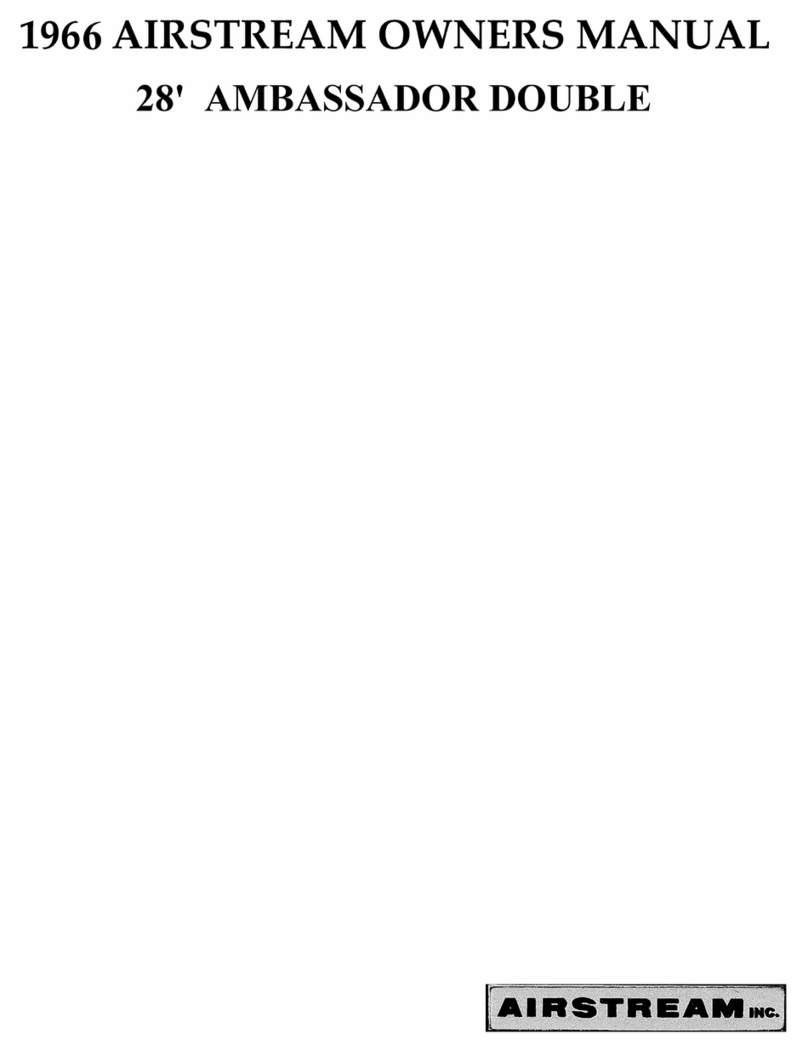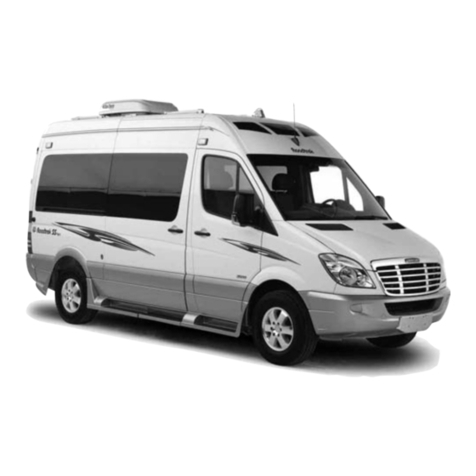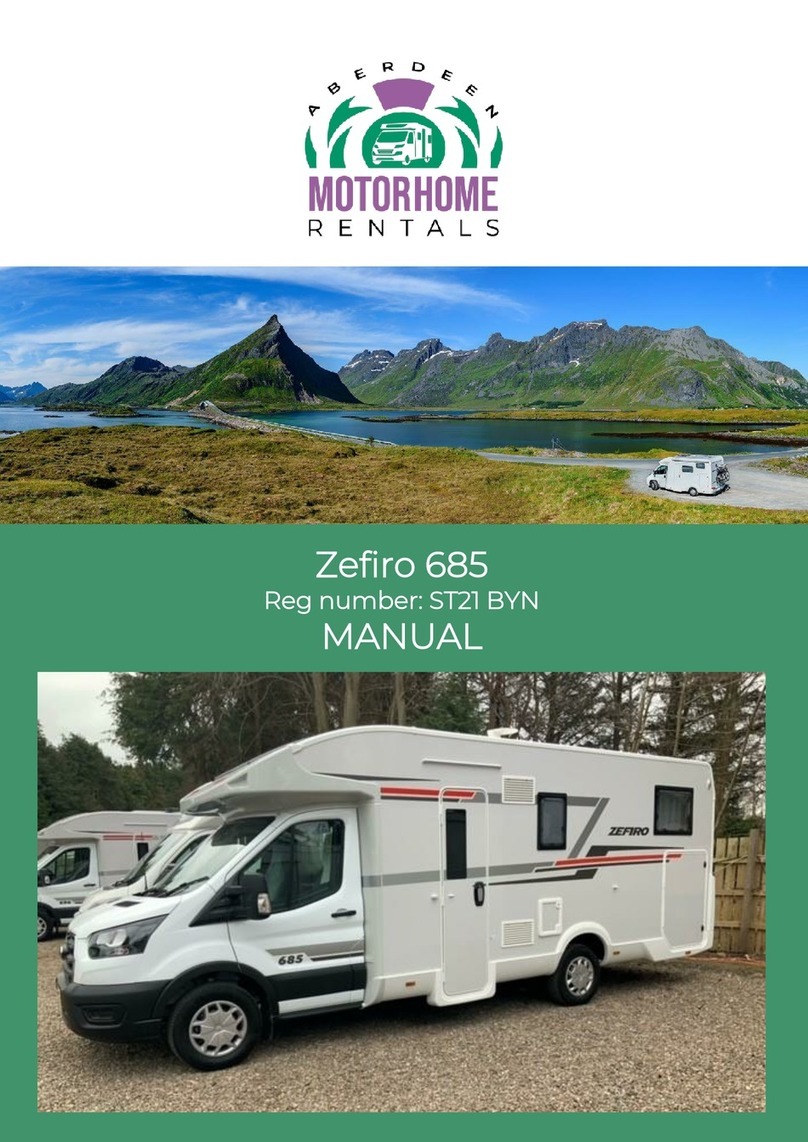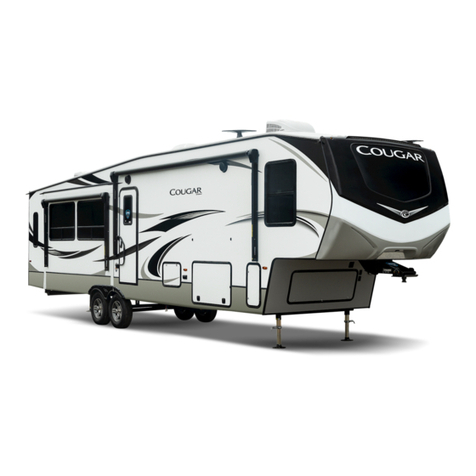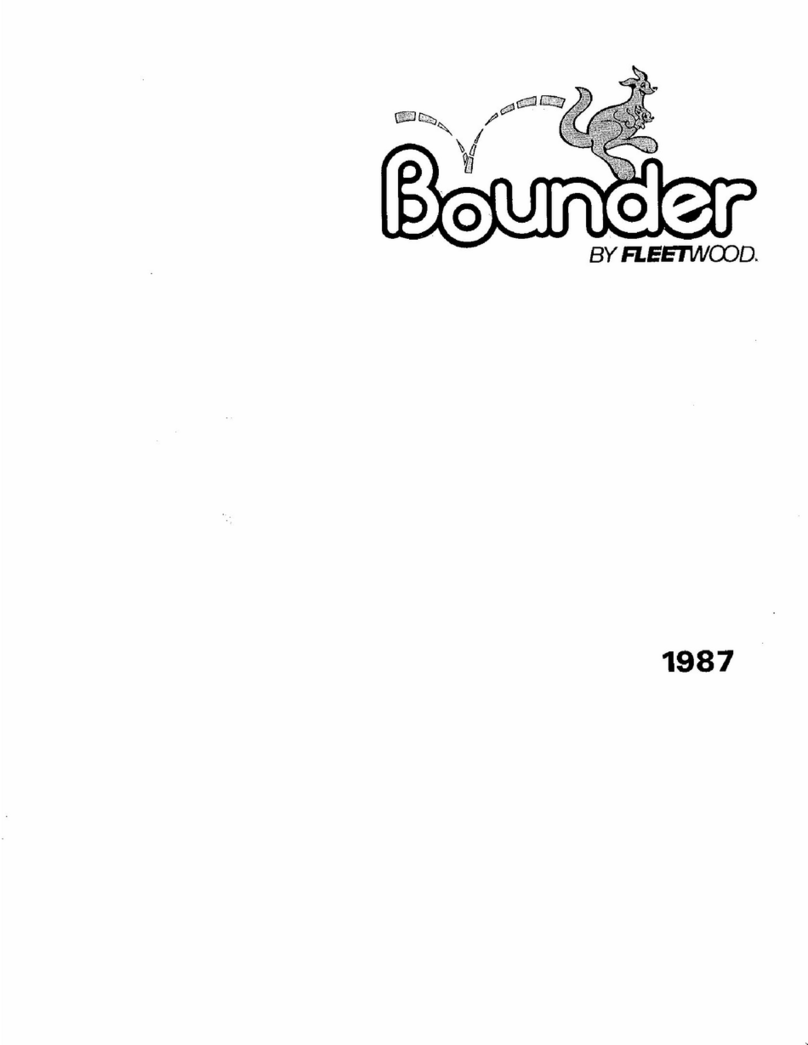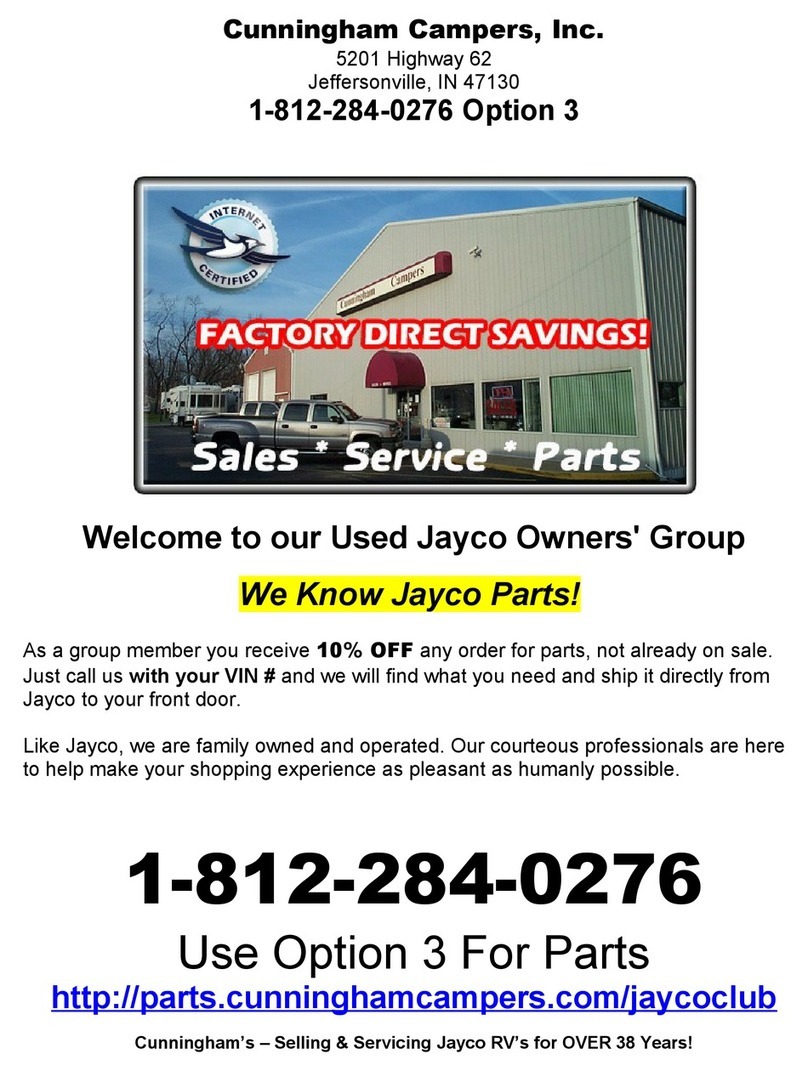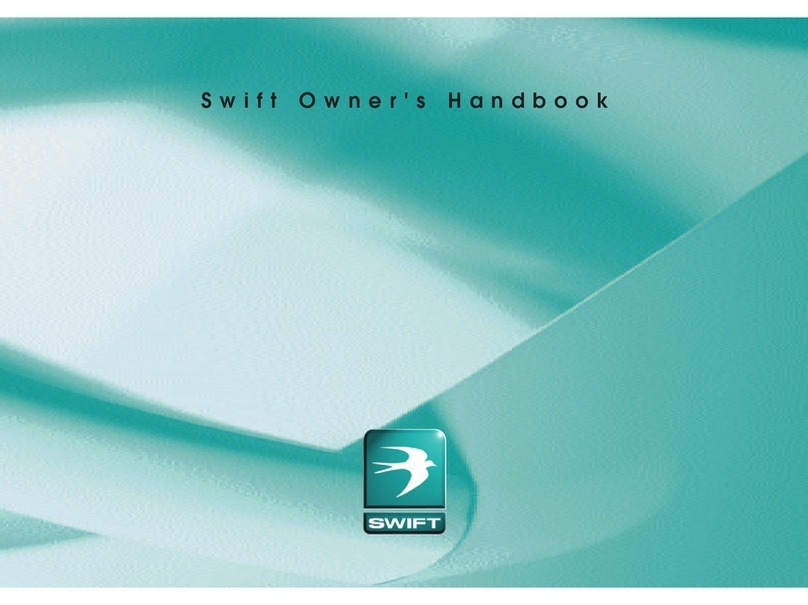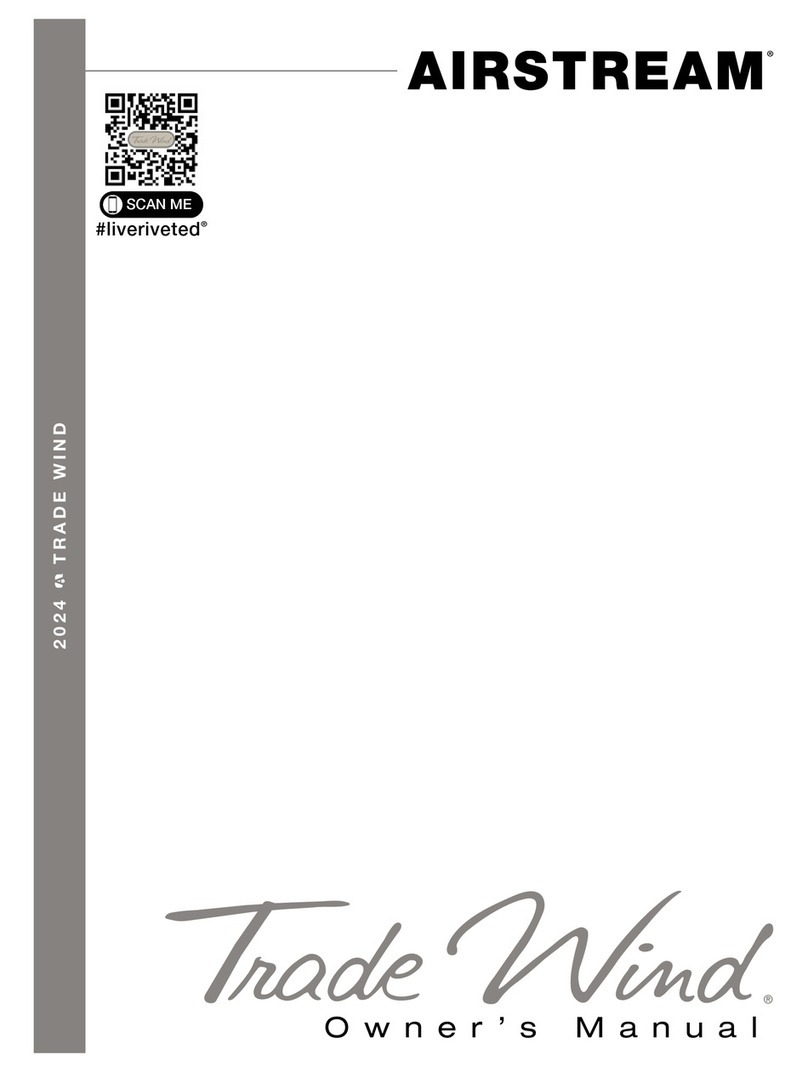Globecar 2 Win User manual

Instruction manu
al
R
eisemobil - 06/02-2 - GLO-0005-00EN
©
2006 Globecar
Instruction manual
Congratulations
We congratulate you on your new Globecar motorhome and would like to thank you for choosing a quality
product from us.
Whatever journey you are planning - you will always have the perfect companion with a Globecar motorhome:
whether it is a city break, a short trip or a family holiday. The innovative and well-thought out floor plans offer
you a variety of options and the contemporary interior design in all our models gives off a homely atmosphere.
You will be amazed at the high standard of quality and all the variations available - space problems are a thing
of the past in our motorhomes. Many practical details will prove extremely useful when on the road and will
allow you to relax even more on your holiday.
Each Globecar motorhome is manufactured with great care and the quality is closely checked. This ensures
that our products have a long service life.
This instruction manual primarily contains information on how to dismantle the living area of your motorhome.
It will give you all important information and tips so that you can enjoy all technical advantages of your
motorhome to the full. We have also included a chapter on maintenance - and thus on the conservation of
value.
In addition, you will find the documents on the base vehicle and the various built-in appliances.
For maintenance work or whenever you need some help, please always get in touch with your Globecar dealer.
They know your motorhome best of all, and will meet all your requests fast and reliably.
We wish you a lot of fun with your motorhome, a relaxing holiday and safe driving at all times.

Reisemobil - 06/02-2 - GLO-0005-00E
N
I
nstruction manual

3R
eisemobil - 06/02-2 - GLO-0005-00EN
Conten
ts
1 Records. . . . . . . . . . . . . . . . . . . . . . . 5
1.1 Vehicle documents . . . . . . . . . . . . . . . . 5
1.2 Warranty . . . . . . . . . . . . . . . . . . . . . . . . 5
1.3 Inspection records. . . . . . . . . . . . . . . . . 6
1.4 Inspection plan . . . . . . . . . . . . . . . . . . . 7
2Introduction. . . . . . . . . . . . . . . . . . . 9
2.1 General . . . . . . . . . . . . . . . . . . . . . . . . 10
2.2 Environmental tips. . . . . . . . . . . . . . . . 10
3Safety. . . . . . . . . . . . . . . . . . . . . . . . 11
3.1 Fire prevention . . . . . . . . . . . . . . . . . . 11
3.1.1 Avoidance of fire risks . . . . . . . . . . . . . 11
3.1.2 Fire-fighting . . . . . . . . . . . . . . . . . . . . . 11
3.1.3 In case of fire. . . . . . . . . . . . . . . . . . . . 11
3.2 General . . . . . . . . . . . . . . . . . . . . . . . . 11
3.3 Road safety. . . . . . . . . . . . . . . . . . . . . 12
3.4 Towing. . . . . . . . . . . . . . . . . . . . . . . . . 13
3.5 Gas system . . . . . . . . . . . . . . . . . . . . . 13
3.5.1 General instructions . . . . . . . . . . . . . . 13
3.5.2 Gas bottles . . . . . . . . . . . . . . . . . . . . . 14
3.6 Electrical system . . . . . . . . . . . . . . . . . 15
3.7 Water system . . . . . . . . . . . . . . . . . . . 15
4 Before the journey . . . . . . . . . . . 17
4.1 Payload . . . . . . . . . . . . . . . . . . . . . . . . 17
4.1.1 Terms . . . . . . . . . . . . . . . . . . . . . . . . . 17
4.1.2 Calculating the payload. . . . . . . . . . . . 18
4.1.3 Loading the motorhome correctly . . . . 19
4.2 Entrance step . . . . . . . . . . . . . . . . . . . 19
4.2.1 Electrically operated entrance step . . . 19
4.3 Television . . . . . . . . . . . . . . . . . . . . . . 20
4.4 Road safety. . . . . . . . . . . . . . . . . . . . . 20
5 During the journey . . . . . . . . . . . 23
5.1 Driving the motorhome . . . . . . . . . . . . 23
5.2 Driving speed . . . . . . . . . . . . . . . . . . . 23
5.3 Seat belts . . . . . . . . . . . . . . . . . . . . . . 23
5.4 Driver's seat and front
passenger's seat . . . . . . . . . . . . . . . . . 24
5.5 Seating arrangement. . . . . . . . . . . . . . 25
5.6 External doors . . . . . . . . . . . . . . . . . . . 25
5.7 Filling up with diesel . . . . . . . . . . . . . . 25
6 Pitching the motorhome . . . . . 27
6.1 Handbrake. . . . . . . . . . . . . . . . . . . . . . 27
6.2 Entrance step . . . . . . . . . . . . . . . . . . . 27
6.3 240 V connection . . . . . . . . . . . . . . . . 27
6.4 Refrigerator . . . . . . . . . . . . . . . . . . . . . 27
7 Living . . . . . . . . . . . . . . . . . . . . . . . . 29
7.1 External flaps . . . . . . . . . . . . . . . . . . . 29
7.1.1 External flap 240 V connection . . . . . . 29
7.1.2 External flap Thetford cassette . . . . . . 29
7.1.3 Cap for the fresh water filler neck . . . . 30
7.2 Ventilation . . . . . . . . . . . . . . . . . . . . . . 30
7.3 Windows . . . . . . . . . . . . . . . . . . . . . . . 31
7.3.1 Hinged window with rotary hinges . . . . 31
7.3.2 Sliding window . . . . . . . . . . . . . . . . . . . 32
7.3.3 Blind and insect screen . . . . . . . . . . . . 33
7.3.4 Roman shades for driver's window
and front passenger's window . . . . . . . 34
7.3.5 Roman shade for the windscreen . . . . 34
7.4 Skylights . . . . . . . . . . . . . . . . . . . . . . . 35
7.4.1 Skylight with snap latch . . . . . . . . . . . . 35
7.4.2 Hinged skylight . . . . . . . . . . . . . . . . . . 36
7.4.3 Hinged sliding roof . . . . . . . . . . . . . . . . 37
7.5 Rotating seats . . . . . . . . . . . . . . . . . . . 38
7.6 Tables . . . . . . . . . . . . . . . . . . . . . . . . . 39
7.6.1 Suspension table with fold-out leg
(without table extension) . . . . . . . . . . . 39
7.6.2 Suspension table with fold-out leg
(with table extension). . . . . . . . . . . . . . 39
7.6.3 Suspension table with separable
support leg . . . . . . . . . . . . . . . . . . . . . . 40
7.6.4 Fixed table of the rear seating group . . 41
7.6.5 Folding table with folding stool. . . . . . . 41
7.7 Halogen lamp. . . . . . . . . . . . . . . . . . . . 42
7.8 Beds. . . . . . . . . . . . . . . . . . . . . . . . . . . 43
7.8.1 Fixed bed . . . . . . . . . . . . . . . . . . . . . . . 43
7.8.2 Pull-down bed . . . . . . . . . . . . . . . . . . . 44
7.9 Converting seating groups for
sleeping . . . . . . . . . . . . . . . . . . . . . . . . 46
7.9.1 Rear seating group . . . . . . . . . . . . . . . 46
7.9.2 Front seating group . . . . . . . . . . . . . . . 47
8 Gas system. . . . . . . . . . . . . . . . . . . 49
8.1 General . . . . . . . . . . . . . . . . . . . . . . . . 49
8.2 Gas bottles. . . . . . . . . . . . . . . . . . . . . . 50
8.3 Changing gas bottles . . . . . . . . . . . . . . 50
8.4 Gas isolator taps . . . . . . . . . . . . . . . . . 51
9 Electrical system . . . . . . . . . . . . . 53
9.1 General safety instructions . . . . . . . . . 53
9.2 12 V power supply . . . . . . . . . . . . . . . . 53
9.2.1 Living area battery . . . . . . . . . . . . . . . . 53
9.3 Transformer/rectifier (EBL 99) . . . . . . . 55
9.3.1 Battery cut-off switch . . . . . . . . . . . . . . 56
9.3.2 Battery selector switch. . . . . . . . . . . . . 56
9.3.3 Battery monitor . . . . . . . . . . . . . . . . . . 56
9.3.4 Charging the battery . . . . . . . . . . . . . . 57
9.4 Panel LT 410 . . . . . . . . . . . . . . . . . . . . 57
9.4.1 V/tank gauge for battery voltage
and water or waste water levels . . . . . 57
9.4.2 Battery alarm for the living
area battery . . . . . . . . . . . . . . . . . . . . . 58
9.4.3 12 V main switch . . . . . . . . . . . . . . . . . 58
9.4.4 12 V indicator lamp . . . . . . . . . . . . . . . 58
9.4.5 240 V indicator lamp . . . . . . . . . . . . . . 59
9.5 240 V power supply . . . . . . . . . . . . . . . 59
9.5.1 240 V connection . . . . . . . . . . . . . . . . . 59
9.6 Fuses . . . . . . . . . . . . . . . . . . . . . . . . . . 59
9.6.1 12 V fuses . . . . . . . . . . . . . . . . . . . . . . 59
9.6.2 Fuse 240 V . . . . . . . . . . . . . . . . . . . . . 61

C
ontents
4
Reisemobil - 06/02-2 - GLO-0005-00E
N
10 Appliances . . . . . . . . . . . . . . . . . . . 63
10.1 General . . . . . . . . . . . . . . . . . . . . . . . . 63
10.2 Heater . . . . . . . . . . . . . . . . . . . . . . . . . 63
10.2.1 To heat properly. . . . . . . . . . . . . . . . . . 64
10.2.2 Trumatic C hot-air heater . . . . . . . . . . . 64
10.2.3 Heater for waste water tank and
waste water pipes (winter comfort
package) . . . . . . . . . . . . . . . . . . . . . . . 65
10.3 Trumatic C boiler . . . . . . . . . . . . . . . . . 66
10.3.1 Safety/drainage valve . . . . . . . . . . . . . 67
10.3.2 Winter operation. . . . . . . . . . . . . . . . . . 67
10.3.3 Summer operation . . . . . . . . . . . . . . . . 67
10.3.4 Filling/emptying the boiler . . . . . . . . . . 68
10.4 Gas cooker. . . . . . . . . . . . . . . . . . . . . . 68
10.5 Refrigerator . . . . . . . . . . . . . . . . . . . . . 69
10.5.1 Refrigerator ventilation grill . . . . . . . . . 70
10.5.2 Operation . . . . . . . . . . . . . . . . . . . . . . 70
10.5.3 Refrigerator door locking
mechanism. . . . . . . . . . . . . . . . . . . . . . 72
11 Sanitary fittings . . . . . . . . . . . . . . 73
11.1 Water supply, general . . . . . . . . . . . . . 73
11.2 Water tank . . . . . . . . . . . . . . . . . . . . . . 73
11.3 Water system . . . . . . . . . . . . . . . . . . . . 74
11.4 Waste water tank . . . . . . . . . . . . . . . . 75
11.5 Toilet compartment . . . . . . . . . . . . . . . 76
11.6 Vario toilet compartment . . . . . . . . . . . 76
11.6.1 Converting into a shower cubicle . . . . . 77
11.6.2 Conversion to toilet compartment . . . . 77
11.7 Thetford toilet . . . . . . . . . . . . . . . . . . . . 78
12 Care . . . . . . . . . . . . . . . . . . . . . . . . . . 81
12.1 External care . . . . . . . . . . . . . . . . . . . . 81
12.1.1 Washing with a high-pressure
cleaner . . . . . . . . . . . . . . . . . . . . . . . . . 81
12.1.2 Windows of acrylic glass . . . . . . . . . . . 81
12.1.3 Waste water tank . . . . . . . . . . . . . . . . . 81
12.1.4 Entrance step. . . . . . . . . . . . . . . . . . . . 82
12.2 Interior care . . . . . . . . . . . . . . . . . . . . . 82
12.3 Winter care. . . . . . . . . . . . . . . . . . . . . . 83
12.3.1 Winter operation. . . . . . . . . . . . . . . . . . 83
12.4 Lay-up . . . . . . . . . . . . . . . . . . . . . . . . . 83
12.4.1 Temporary lay-up. . . . . . . . . . . . . . . . . 83
12.4.2 Winter lay-up . . . . . . . . . . . . . . . . . . . . 84
12.4.3 Starting up the vehicle after a
temporary lay-up or after lay-up over
winter . . . . . . . . . . . . . . . . . . . . . . . . . . 85
13 Maintenance. . . . . . . . . . . . . . . . . . 87
13.1 Inspection work . . . . . . . . . . . . . . . . . . 87
13.2 Maintenance work . . . . . . . . . . . . . . . . 87
13.3 Replacing bulbs and
fluorescent tubes . . . . . . . . . . . . . . . . . 87
13.3.1 Ceiling lamp . . . . . . . . . . . . . . . . . . . . . 88
13.3.2 Room lamp. . . . . . . . . . . . . . . . . . . . . . 88
13.3.3 Surface-mounted halogen light
(swivelling) . . . . . . . . . . . . . . . . . . . . . . 89
13.4 Spare parts . . . . . . . . . . . . . . . . . . . . . .89
13.5 Vehicle identification plate . . . . . . . . . .90
13.6 Warning and information stickers . . . . .90
14 Troubleshooting . . . . . . . . . . . . . .91
14.1 Electrical system. . . . . . . . . . . . . . . . . .91
14.2 Gas system. . . . . . . . . . . . . . . . . . . . . .92
14.3 Cooker . . . . . . . . . . . . . . . . . . . . . . . . .93
14.4 Heater/boiler . . . . . . . . . . . . . . . . . . . . .93
14.5 Refrigerator. . . . . . . . . . . . . . . . . . . . . .94
14.6 Water supply. . . . . . . . . . . . . . . . . . . . .95
14.7 Body . . . . . . . . . . . . . . . . . . . . . . . . . . .96
15 Technical data . . . . . . . . . . . . . . . .97
15.1 Weights. . . . . . . . . . . . . . . . . . . . . . . . .97
15.2 Dimensions. . . . . . . . . . . . . . . . . . . . . .97
15.3 Equipment . . . . . . . . . . . . . . . . . . . . . .98

5R
eisemobil - 06/02-2 - GLO-0005-00EN
Records
1
1Records
1.1 Vehicle documents
We reserve the right to alter the construction, equipment and the scope of
delivery. Special equipment is also listed that is not included in the standard
scope of delivery. The descriptions and illustrations in this brochure do not
relate to a particular version. For all details, only the respective equipment list
is valid.
1.2 Warranty
1. The valid guarantee and product warranty regulations apply to the vehicle.
2. In the event of pursuing possible claims against a guarantee, it is useful to
have the vehicle inspected by a Globecar dealer at the end of the first year.
The presentation should take place 2 months at the latest after the anniver-
sary of the initial registration (or delivery).
The Globecar dealer should stamp, date and sign the page provided in this
instruction manual as proof that the inspection was carried out.
3. The costs of the inspection are to be paid by the vehicle owner.
Vehicle data
Model:
Car manufacturer/type of engine:
Serial number:
Initial registration:
Purchased from company:
Key number:
Chassis number:
Customer address
Surname, Christian name:
Street, no.:
Postal code, town:
E-mail:
Dealer's stamp and signature

6
Reisemobil - 06/02-2 - GLO-0005-00E
N
Records
1
1.3 Inspection records
Should it be determined during an inspection that additional work is necessary,
then the carrying out of this work is dependent on the customer commissioning
this to be done. Please also adhere to the service intervals stipulated by the
manufacturers of the individual equipment. Information is included in the
service documents enclosed.
Delivery
Signature and stamp of the Globecar dealer:
1st year
Signature and stamp of the Globecar dealer:
No defects found
Found defects:

7R
eisemobil - 06/02-2 - GLO-0005-00EN
Records
1
1.4 Inspection plan
We reserve the right to modify the inspection plan.
Pos. Component Activity Interval
1Joints, hinges Lubrication Annually
2Refrigerator, heater, boiler,
cooker, lighting, storage flap
and door closures, toilet, seat
belts
Function check Annually
3Windows, skylights Function check, water
ingress test
Annually
4Upholstery, curtains, blinds Visual check Annually
5Sealing strips, edges, rubber Check for damage Annually
6Water supply Water ingress test Annually
7Hot-air system Function check, clean
fan wheel as necessary
Annually
8Underbody protection, attach-
ing the underbody equipment
Visual check Annually
9Electrical system Function check Annually
10 Gas system Official gas inspection Every two
years
11 Underbody Visual check, repair un-
derbody protection as
necessary
Every two
years

8
Reisemobil - 06/02-2 - GLO-0005-00E
N
Records
1

9R
eisemobil - 06/02-2 - GLO-0005-00EN
Introduction
2
2Introduction
Please read this instruction manual completely before
using the vehicle for the first time!
Always keep this instruction manual in the vehicle. Also inform all other users
of the safety regulations.
This instruction manual contains sections which describe model-specific
equipment or special equipment. These sections are not specially marked. It
may be that your vehicle has not been fitted with this special equipment. In
some cases, the actual equipment of your vehicle may therefore be different
from that shown in some illustrations and descriptions.
However, your vehicle may be fitted with other special equipment not
described in this instruction manual.
Special equipment is described when an explanation is required.
Adhere to the instruction manuals which are separately enclosed.
Should the vehicle be subjected to damage due to a failure to follow the
instructions in this instruction manual, then the guarantee claim is deemed
invalid.
Our vehicles are subjected to continuous development. Please understand
that we reserve the right to alter the form, equipment and technology. There-
fore, no claims can be made against the manufacturer as a result of the con-
tents of this instruction manual. The equipment which was known and included
at the time of going to press is described.
The reprinting, translation and copying, including extracts is not permitted
without prior written authorisation from the manufacturer.
The non-observance of this symbol can lead to personal injury.
The non-observance of this symbol can lead to damage being caused to,
or inside the vehicle.
This symbol indicates recommendations or special aspects.
This symbol indicates actions which lead to environmental awareness.
The details "right", "left", "front" and "rear" always refer to the vehicle in
direction of travel.
All dimensions and weight details are "approximate".
The metric specifications are binding for physical dimensions.

1
0Reisemobil - 06/02-2 - GLO-0005-00E
N
Introduction
2
2.1 General
The vehicle is constructed in accordance with the latest technology and the
recognised safety regulations. Nevertheless, personal injury may result and
the vehicle may be damaged if the safety instructions in this instruction manual
are not followed.
Only use the vehicle in a technically impeccable condition. Follow the instruc-
tions in the instruction manual.
Malfunctions which impair the safety of persons or the vehicle should be
immediately remedied by qualified personnel.
Have the vehicle's braking and gas systems inspected and repaired by an
authorised specialist workshop only.
Alterations to the body are only to be carried out with the authorisation of the
manufacturer.
The vehicle is designed for the exclusive transport of persons. Luggage and
accessories may only be transported up to the maximum permissible gross
weight.
Observe the test or inspection periods stipulated in the instruction manual.
2.2 Environmental tips
Remember that: All kinds of waste water and household waste are not to
be disposed of in drains or in the open countryside.
Only empty the waste water tank and Thetford cassette at disposal sta-
tions, at camping sites or caravan sites, that are especially provided for this
purpose. When stopping in towns and communities, observe the instruc-
tions at caravan sites or ask where there are disposal stations.
Empty waste water tank as often as possible, even when it is not com-
pletely full (hygiene).
If possible, flush out waste water tank and drainage pipe with fresh water
every time it is emptied.
Never allow the Thetford cassette to become too full. Empty the Thetford
cassette frequently, at the latest as soon as the filling level display lights up.
Separate household waste according to glass, tin cans, plastic and wet
waste also when on a journey. Enquire at the town or community authority
about disposal points. Household waste is not to be disposed of in waste
paper baskets which are situated at car parks.
Empty waste bins as often as possible into the containers provided for this
purpose. This helps to avoid unpleasant smells and an accumulation of
rubbish on board.
When parked, do not allow the engine to run more than necessary. When
running idle, a cold engine releases more contaminants than usual. The
running temperature of the engine is achieved more quickly whilst the
vehicle is in motion.
Use an environmentally-friendly WC chemical agent for the WC which can
also be biologically degraded and only use small doses.
When staying in towns and communities for long periods, search for
parking areas that are specially reserved for motorhomes. Enquire at the
town or community authority about parking spaces.

1
1R
eisemobil - 06/02-2 - GLO-0005-00EN
Safety
3
3Safety
3.1 Fire prevention
3.1.1 Avoidance of fire risks
3.1.2 Fire-fighting
3.1.3 In case of fire
3.2 General
Never leave children in the vehicle unattended.
Keep flammable materials clear of heating and cooking appliances.
Lights can get very hot. When the light is switched on, there must always
be a safety distance of 30 cm between light and flammable objects. Fire
hazard!
Never use portable heating or cooking appliances.
Only authorised qualified personnel may make changes to the electrical
system, gas system or appliances.
Always have a dry powder fire extinguisher in the vehicle (with at least
1 kg capacity). The fire extinguisher must be approved, tested and close
at hand.
Have the fire extinguisher tested at regular intervals by authorised qual-
ified personnel. Observe the date of testing.
The fire extinguisher is not included in the scope of delivery of the
vehicle.
Evacuate vehicle passengers.
Cut off the electrical power supply and disconnect from the mains.
Close regulator tap on the gas bottle.
Sound the alarm and call the fire brigade.
Fight the fire if this is possible without risk.
Keep escape routes clear.
Observe the fire extinguisher instructions for use.
The oxygen in the vehicle interior is used up by breathing or the use of
the gas cooker or other appliances. That is why the oxygen needs to be
replaced on a constant basis. For this purpose, forced ventilations are
fitted in the vehicle. Never cover or block forced ventilations with objects
such as e.g. a winter mat. Keep forced ventilations clear of snow and
leaves. There is a danger of suffocation due to increased CO2levels.
Gas pipes and electric lines are laid in the floor. Never drill holes in the
floor or insert any any screws. That could cause a gas explosion, an
electrical shock or a short circuit due to damage to a cable.

1
2Reisemobil - 06/02-2 - GLO-0005-00E
N
Safety
3
3.3 Road safety
As far as the fitted appliances (heater, cooker, refrigerator, etc.) and the
base vehicle (engine, brakes, etc.) are concerned, the instruction manuals
are authoritative. It is imperative that they be observed.
Fitting accessories or special equipment can alter the dimensions, weight
and road behaviour of the vehicle. Some of the parts must be entered in
the vehicle papers.
Firmly apply the handbrake when parking the vehicle.
When leaving the vehicle, it is imperative that all doors, external flaps and
windows are closed.
Carry a hazard warning triangle and first-aid kit in accordance with national
regulations.
When selling the vehicle, hand over all instruction manuals for the vehicle
and the fitted appliances.
Before commencing the journey, carry out a functional check of indi-
cating and lighting equipment, the steering and the brakes.
If the vehicle has been stationary for a long period (approx. 10 months)
have the braking and gas systems checked by an authorised specialist
workshop.
Before commencing the journey and after short interruptions of the
journey, ensure that the entrance step is completely retracted.
Before commencing the journey, secure the hinged pull-down bed to the
roof using the retaining belt.
Before commencing the journey, open and secure the shades on the
windscreen and on the driver's and front passenger's windows.
Before commencing the journey, rotate all swivel seats in the direction
of travel and lock in position. During the journey, the swivel seats must
remain locked in place in the direction of travel.
Before commencing the journey, remove the television from the support
and store it securely.
During the journey, the seats are only to be occupied by persons (see
chapter 5). The authorised number of seats is stipulated in the vehicle
documents.
Fasten your seat belts before the beginning of the journey and keep
them fastened during the journey.
Always secure children with the children safety equipment prescribed for
the respective height and weight.
Factory-set three-point safety belts must be used when attaching child
restraint systems.
The base vehicle is a commercial vehicle (small truck). Adjust your
driving technique accordingly.
When driving through underpasses, tunnels, etc. observe the overall
height of the vehicle (refer to the technical data in the vehicle docu-
ments).
In winter, the roof must be free of snow and ice before commencing the
journey.

1
3R
eisemobil - 06/02-2 - GLO-0005-00EN
Safety
3
3.4 Towing
3.5 Gas system
3.5.1 General instructions
Before commencing the journey, distribute the payload evenly within the
vehicle (see chapter 4).
When loading the vehicle and when taking a rest from driving, in order to
load luggage or food, for example, observe the maximum permissible
gross weight and axle loads (refer to vehicle documents).
Before commencing the journey, ensure that all cupboard doors, the toilet
compartment door and all drawers and flaps are secure. Engage the refrig-
erator door securing device. Lock the concertina wall of the Vario toilet
compartment.
Before commencing the journey, close windows and skylights.
Before commencing the journey, close all external flaps and lock them.
Before commencing the journey, remove external steady legs.
Care is to be taken when connecting and detaching a trailer. Risk of acci-
dent and injury!
No persons are to be between the motorhome and the trailer during posi-
tioning for connecting and detaching.
Close all gas isolator taps and the regulator tap before commencing the
journey and when leaving the vehicle. Exception: If you plan to use the
living area heater during the journey, leave the "Heater" gas isolator tap
and the regulator tap on the gas bottle open.
No source of combustion using gas (gas cooker, gas heater, gas boiler,
etc.) may be in operation when filling the fuel tank, on ferries or in the
garage. Danger of explosion!
Only have the gas system maintained, repaired or altered by an author-
ised specialist workshop.
Have the gas system checked by an authorised specialist workshop
according to the national regulations before commissioning. This also
applies for not registered vehicles. For modifications to the gas system
have the gas system immediately checked by an authorised specialist
workshop.
The gas pressure regulator and exhaust gas pipes must also be
inspected. We recommend having the gas pressure regulator checked
no later than every 10 years.
In case of a defect of the gas system (gas odour, high gas consumption)
there is danger of explosion! Close regulator tap on the gas bottle imme-
diately. Open doors and windows and ventilate well.
If the gas system is defective: Do not smoke; do not ignite any open
flames, and do not operate electric switches (light switches etc.).
Have the defective gas system repaired by an authorised specialist
workshop.
Open a skylight before taking open sources of combustion (gas cooker)
into service.
Do not use the gas cooker for heating purposes.

1
4Reisemobil - 06/02-2 - GLO-0005-00E
N
Safety
3
3.5.2 Gas bottles
If the vehicle or gas devices are not used, close the regulator tap on the
gas bottle.
If there are several gas devices, each gas device must have its own gas
isolator tap. If individual gas devices are not in use, close the respective
gas isolator tap.
Ignition safety valves must close within 1 minute after the gas flame has
extinguished. A clicking sound is audible. Check function from time to
time.
The built-in gas devices are exclusively meant for use with propane or
butane gas or a mixture of both. The gas pressure regulator as well as
all built-in gas devices are designed for a gas pressure of 30 mbar.
Propane gas is capable of gasification up to -42 °C, whereas butane gas
gasifies at 0 °C. Below these temperatures no gas pressure is available.
Butane gas is unsuitable for use in winter.
Regularly inspect the gas tube fitted to the gas bottle connection for
tightness. The gas tube must not have any tears and must not be
porous. Have the gas tube replaced by an authorised specialist work-
shop no later than ten years after the manufacturing date. The operator
of the gas system must see to it that the parts are replaced.
Due to its function and construction, the gas bottle compartment is a
space which is open to the exterior. Never cover or block up the standard
forced ventilations. Otherwise gas that is emitted can not be diverted to
the outside.
Do not use the gas bottle compartment as storage space as it is not
moisture-proof.
The regulator tap on the gas bottle must be accessible.
The exhaust gas pipe must be fitted tightly to the heating system and to
the vent and must be sealed. The exhaust gas pipe must not show any
evidence of damage.
Exhaust fumes must be able to escape into the atmosphere unhindered
and fresh air must be able to enter unhindered. For this reason, no snow
walls or aprons may be allowed to lie against the vehicle. Keep the
intake openings under the floor of the vehicle open and clean.
Gas bottles are only to be transported within the designated gas bottle
compartment.
Place the gas bottles in vertical position in the gas bottle compartment.
Fasten the gas bottles so that they are unable to turn or tilt.
If the gas bottles are not connected to the gas tube, always place the
protective cap on top.
Close the regulator tap on the gas bottle before the gas pressure regu-
lator or gas tube are removed from the gas bottle.
Only use special gas pressure regulators with a safety valve designed
for vehicle use. Other gas pressure regulators are not permitted and
cannot meet the demanding requirements.
Use only 11 kg or 5 kg gas bottles! Camping gas bottles with built-in
check valve (blue bottle with max. 2.5 or 3 kg content) are can be used
in exceptional cases with a safety valve.

1
5R
eisemobil - 06/02-2 - GLO-0005-00EN
Safety
3
3.6 Electrical system
3.7 Water system
Only allow qualified personnel to work on the electrical system.
Prior to carrying out work on the electrical system, switch off all devices
and lights, disconnect the batteries and disconnect the 240 V power
cable from the mains.
Only use original fuses with the stipulated values.
Only replace defective fuses when the cause of the defect is known and
has been remedied.
Never bridge or repair fuses.
If the vehicle is not heated when there is risk of frost, empty the entire water
system. Leave the water taps on in central position. Leave the safety/
drainage valve (Trumatic) and all drain cocks open. This will avoid frost
damage to appliances and to the vehicle.
Water left standing in the water tank or in the water pipes becomes undrink-
able after a short period. For this reason, rinse the water pipes and the
water tank thoroughly with several litres of fresh water before each use of
the vehicle. To do this, open all water taps. After each use of the vehicle
completely empty the water tank and the water pipes.

1
6Reisemobil - 06/02-2 - GLO-0005-00E
N
Safety
3

1
7R
eisemobil - 06/02-2 - GLO-0005-00EN
Before the journey
4
4Before the journ ey
4.1 Payload
On loading, make sure that the payload's centre of gravity is as low as possible
(directly above the floor of the vehicle). Otherwise this may affect the driving
characteristics of the vehicle.
4.1.1 Terms
Maximum permissible
gross weight in a laden
condition
In the vehicle documents, the manufacturer has specified the maximum per-
missible gross weight in a laden condition.
Mass in ready-to-drive
condition
In the vehicle documents, the manufacturer specifies the mass in ready-to-
drive conditions.
Payload The payload is made up as follows:
Conventional load
Additional equipment
Personal equipment
You will find explanations on the individual components of the payload in the
following text.
Conventional load The conventional load is the weight specified by the manufacturer for the pas-
sengers.
Conventional load means: 75 kg are calculated for every seat specified by the
manufacturer, regardless of how much the passengers actually weigh. The
driver's seat is already included as part of the mass in ready-to-drive condition
and must not be calculated as part of the conventional load.
In the vehicle documents, the manufacturer specifies the number of seats.
Additional equipment Additional equipment includes accessories and special equipment. Examples
of additional equipment include:
Caravan coupling
Roof racks
Awning
Bike or motorcycle rack
Satellite unit
Overloading the vehicle and wrong tyre pressure can cause tyres to
burst. You can lose control of the vehicle.
Adapt the speed to the payload. The stopping distance is increased if the
payload is too high.
Do not exceed the maximum permissible gross weight stated in the vehicle
documents by the payload.
Built-in accessories, special equipment, the full water tank and the gas bot-
tles all reduce the payload.
Adhere to the axle load stated in the vehicle documents.
Technically speaking, the term "mass" has now replaced the term "weight".
However, "weight" is still the term more frequent in common use. For better
understanding, "mass" is therefore only used in the following sections for
fixed formulations.

1
8Reisemobil - 06/02-2 - GLO-0005-00E
N
Before the journey
4
Information about the weights of the various special equipment devices can be
obtained from the manufacturer.
Personal equipment Personal equipment includes all items in the vehicle that are not included in
the conventional load or in the additional equipment. For example, personal
equipment can include the following:
Foodstuffs
Crockery
Television
Radio
Clothes
Bedding
Toys
Books
Toiletries
No matter where kept, personal equipment also includes:
Animals
Bikes
Boats
Surfboards
Sports equipment
4.1.2 Calculating the payload
The payload (see section 4.1.1) is the difference in weight between
Maximum permissible gross weight in a laden condition and
Vehicle mass complete in a ready-to-drive condition.
The payload calculation at the factory is partly based on all-inclusive
weights. For safety reasons, the maximum permissible gross weight in
a laden condition must not be exceeded.
Only the maximum permissible gross weight and the mass in a ready-to-
drive condition, not the actual weight of the vehicle, is stated in the
vehicle documents. For your own safety, we recommend that you have
your loaded vehicle (with passengers) weighed on a public weighbridge
before you set out on your journey.
Mass in kg to be
calculated
Calculation
Example for calculating
the payload
Maximum permissible gross weight ac-
cording to vehicle documents
3300
Vehicle mass in a ready-to-drive condi-
tion, including basic equipment in accord-
ance with vehicle documents - 2720
This results in a permissible payload
of 580
Conventional load e.g.: 3 persons each
weighing 75 kg
- 225
Additional equipment - 40
For the personal equipment this re-
sults in
= 315

1
9R
eisemobil - 06/02-2 - GLO-0005-00EN
Before the journey
4
The calculation of the payload from the difference between the maximum per-
missible gross weight in laden condition and the mass specified by the manu-
facturer in ready-to-drive condition is however only a theoretical value.
Only if the vehicle is weighed with full tanks (fuel and fresh water), full gas bot-
tles and complete additional equipment on a public weighbridge, can the
actual payload be determined.
4.1.3 Loading the motorhome correctly
4.2 Entrance step
4.2.1 Electrically operated entrance step
Operating switch The switch (Fig. 1,2) to operate the entrance step is located on the inside of
the vehicle in the area of the conversion door.
Distribute the load evenly on the left and right sides of the vehicle.
Distribute the load evenly on both axles. In doing so, observe the axle
loads specified in the vehicle documents. Observe the permissible load-
carrying capacity of the tyres.
Store all objects in such a way that they cannot slip.
Store heavy objects (tent poles, tin cans, etc.) close to the axles.
Low-lying storage compartments whose doors do not open in the direc-
tion of travel or underfloor storage compartments are particularly suited
for storing heavy objects.
Stack light objects (laundry) in the roof storage cabinets.
Before commencing the journey and after short interruptions of the
journey, ensure that the entrance step is completely retracted.
Do not stand in the direct range of the entrance step while it is being
retracted or extended.
Do not step on the entrance step until it has extended completely. There
is a risk of injury.
Do not under any circumstances raise or lower persons or loads with the
entrance step.
Do not grease or lubricate the pivot bearing and joints of the entrance step
(see chapter 12).

2
0Reisemobil - 06/02-2 - GLO-0005-00E
N
Before the journey
4
Extending:
Press the front half of the rocker switch (Fig. 1,1) until the entrance step
has extended completely.
Retracting:
Press the rear half of the rocker switch (Fig. 1,3) until the entrance step has
retracted completely.
4.3 Television
4.4 Road safety
Before commencing the journey, work through the checklist:
Fig. 1 Operating switch entrance
step
Before commencing the journey, remove the television from the support
and store it securely.
Check tyre pressure before a journey or every 2 weeks. Wrong tyre
pressure causes excessive wear and can lead to damage or even to tyre
burst. You can lose control of the vehicle.
No. Checks Checked
Base vehicle 1All vehicle documents are on board
2Tyres in proper condition
3Vehicle lighting, brake lights and reversing lights function
4Oil levels for engine, gearbox and power steering controlled
5Coolant and fluid for windscreen washers filled up
6Brakes function
7Brakes react evenly
8When braking, the vehicle remains in the lane
This manual suits for next models
4
Table of contents
Other Globecar Motorhome manuals


